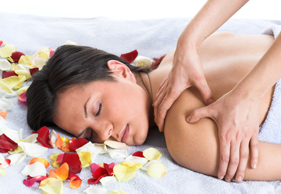Massage therapy dates back to 3000 BC in Chinese
literature, while soldiers in Ancient Greece were given massages during
training and famous Ancient Greek physician Hippocrates (born 460 BC) claimed
that he could improve joint function and muscle tone with massage. Over the
years, massage therapy has taken on many forms, including Aromatherapy, Hot
Stone, Shiatsu, Reflexology and many more, and today sports massage has become
very popular among runners. It is a combination of deep massage, cross-fibre
friction, Swedish massage, trigger point therapy and stretching – depending on
the timing of the massage and the needs of the athlete.
There is no doubt that massage holds numerous direct
physical benefits:
?
Increased blood
circulation to muscles and connective tissue, which improves oxygen and
nutrient supply, and possibly the removal of metabolic by-products. This can
reduce muscle tension and fatigue, and quicken recovery time.
?
Helps to open tissue
membranes, allowing nutrient-flow into the muscles.
?
Increased lymph
circulation, which can boost immune function.
?
When a muscle is
injured, it heals with collagen, leaving a scar, and the resulting scar tissue
is weaker and less elastic. Massage and stretching can help the scar tissue
fibres to align and integrate with muscle fibres, allowing the muscle to regain
normal strength and flexibility.
?
Massage reduces
stress by activating the para-sympathetic nervous system, which slows the heart
rate and prepares the body for a state of relaxation.
TIMING IS KEY
Although a once-off massage will have these beneficial
effects, most are relatively short-lived. The value of massage to prevent
injuries, shorten recovery time and remove adhesions really becomes evident when
having regular treatments. A runner will therefore benefit from weekly
massages, especially if you are following a high-intensity training programme,
but even a monthly massage will be beneficial.
The pre-event massage: Book your last massage three to five days before your event, since it
can lead to some soreness. Therefore, rather avoid going for a massage at the
expo of a big race, because the therapist does not know you or your body’s response
to massage, and it does not allow for sufficient recovery time before your
race. Also, while a massage directly before your event will help with blood
circulation, it will activate your “relaxing” nervous system and hormones,
preparing your body for a state of rest instead of competition. However, a very
nervous athlete may benefit from a relaxing pre-event massage, provided it is
followed by a dynamic warm-up.
The post-event massage: A post-event/training massage will not prevent DOMS (delayed onset of
muscle soreness) by “flushing out toxins like lactic acid”. Firstly, lactate is
not a toxin, it is an end-product of glucose metabolism, and does not cause
DOMS. Secondly, lactate is circulated out of the working muscles and blood
within an hour, and used by the brain and muscles for energy. DOMS is in fact caused
by microscopic muscle tears and a deep massage can increase this tissue damage.
Therefore, a light massage directly after a race can purely assist in the venous
blood-flow out of your legs. Rather wait three to five days – until muscle
soreness is gone – before your next deep massage.
CHECK IT OUT
A really good option for runners is Myofascial release,
a relatively new form of massage therapy. The fascia is the sheath that wraps
and separates individual muscles and also helps to absorb some of the physical
stress during exercise. The fascia can dehydrate and shrink with regular
physical activity, which will lead to compression of the muscle and resulting
reduced circulation, limited range of motion, and pain. This massage technique
helps to restore the fascia to its natural state, and also
stimulates neural receptors which decrease muscular tension.
It is important to make sure that your massage
therapist did an accredited massage course. If injured, first seek medical
advice from your doctor or sport physician and get treated by a physiotherapist.
You can also benefit from an exercise programme from a biokineticist. Once the
injury is sorted out, carry on with your training and regular massage treatments
to ensure happy, healthy muscles and prevent injuries.

